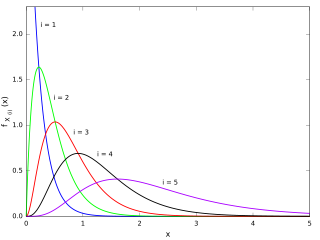In probability theory, the multinomial distribution is a generalization of the binomial distribution. For example, it models the probability of counts for each side of a k-sided dice rolled n times. For n independent trials each of which leads to a success for exactly one of k categories, with each category having a given fixed success probability, the multinomial distribution gives the probability of any particular combination of numbers of successes for the various categories.
When k is 2 and n is 1, the multinomial distribution is the Bernoulli distribution. When k is 2 and n is bigger than 1, it is the binomial distribution. When k is bigger than 2 and n is 1, it is the categorical distribution. The term "multinoulli" is sometimes used for the categorical distribution to emphasize this four-way relationship (so n determines the suffix, and k the prefix).
The Bernoulli distribution models the outcome of a single Bernoulli trial. In other words, it models whether flipping a (possibly biased) coin one time will result in either a success (obtaining a head) or failure (obtaining a tail). The binomial distribution generalizes this to the number of heads from performing n independent flips (Bernoulli trials) of the same coin. The multinomial distribution models the outcome of n experiments, where the outcome of each trial has a categorical distribution, such as rolling a k-sided die n times.
Let k be a fixed finite number. Mathematically, we have k possible mutually exclusive outcomes, with corresponding probabilities p1, ..., pk, and n independent trials. Since the k outcomes are mutually exclusive and one must occur we have pi ≥ 0 for i = 1, ..., k and . Then if the random variables Xi indicate the number of times outcome number i is observed over the n trials, the vector X = (X1, ..., Xk) follows a multinomial distribution with parameters n and p, where p = (p1, ..., pk). While the trials are independent, their outcomes Xi are dependent because they must be summed to n.

























































































































































